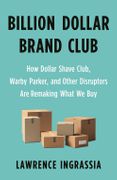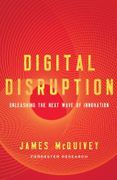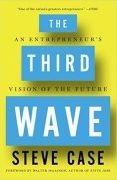
A 5 Minute Overview Of
Billion-Dollar Brand Club
How Dollar Shave Club, Warby Parker, and Other Disruptors Are Remaking What We Buy
About the Author
Lawrence Ingrassia is a journalist. He is a former business and economics editor at the New York Times, where he also served as deputy managing editor. He worked for twenty-five years at the Wall Street Journal as Boston Bureau Chief, London Bureau Chief, Money & Investing Editor, and Assistant Managing Editor. His first job was as a reporter at the Chicago Sun-Times. He currently serves as a special committee member at Dow Jones & Company, Inc. Lawrence Ingrassia is a graduate of the University of Illinois at Urbana-Champaign.
The Main Idea
It's never been a better time to start a new DTC (direct-to-consumer) brand. If you get it right, it's now possible to grow a billion-dollar brand faster than ever before. Exhibit A is Michael Dubin, who parlayed a witty 90-second video — which cost all of $4,500 to make — into the Dollar Shave Club brand which Unilever acquired for $1 billion. Time taken: less than five years!
The dirty little secret of Dollar Shave Club, Warby Parker, and all the other billion-dollar brands is their products are not necessarily better. Instead, they take a digital approach to retail, and reap the benefits. They innovate by getting to know the customer better than the big players, and then find a dimension to compete on that the established brands just kind of gloss over and ignore.
To build a billion-dollar brand, you don't necessarily need a superior product. You just need to know what makes your customers tick, and come up with something better they will value. Digital tools enable you to figure that out and deliver it. Obsess over connecting and bonding with your customer and all else will follow.
The good news for brands, new and old, is that the market for consumer products isn't just tens of billions or even hundreds of billions of dollars a year, but several trillion dollars a year in the United States alone. That leaves plenty of room for start-ups, with the most successful ones joining the billion dollar brand club. After all, they could be a $1 razor blade and a one-minute, thirty-three-second video away from making it happen.
The Secrets of Building Billion Dollar Brands
Principle #1 — Sell direct to consumers. The success of Dollar Shave Club showed that by targeting a corporate giant's weakness, a start-up with the right product, the right amount of added value, and the right message can create a new brand almost overnight. You don't even have to invent a better product or having lots of money for advertising to succeed. You just have to align with what customers are thinking.
Principle #2 — Find stale categories. Warby Parker is a great example of what direct-to-consumer brands offer. It succeeded because the usual category leaders sell largely through retailers and depend on broadcast advertising. That means they don't have a direct connection with customers. Furthermore, if the category leader enjoys large profit margins, they will be less likely to cannibalize their own business model and compete. These are the sweet spots for new DTC brands.
Principle #3 — Use data to learn. Most people assume direct-to-consumer brands are all about the digital distribution channel, but that's not actually correct. These brands use data to connect and listen to their customers, to bond with them, to learn what they want, and then to find ways to work with customers going forward. "The algorithm is always right" is the mantra of billion-dollar brand builders.
Principle #4 — Never lose sight of the customer. In what is almost a classic Back to the Future moment, many direct-to-consumer brands are now opening physical retail stores, despite them proclaiming physical retail is so last century. The difference is these stores are now used to gather customer data which is then applied to increasing online direct-to-consumer sales. It's about making connections rather than sales. The legacy retailers were sitting on a goldmine of customer data they never took advantage of.
Key Takeaways
- The key to building a billion-dollar brand is not necessarily to build a better product. Instead, you need to know and bond with your customers, and align with what they think and do. Add value for them and you can create and grow a brand almost overnight.
- There's never been a better time than right now to build and grow a new direct-to-consumer brand. Today's digital tools make it possible to know what makes your customers tick, and what they value better than ever before. Obsess over connecting with your customer and all else will follow.
In the digital economy, your audience has an audience. Customers will interact with a brand in a social channel, they'll share it with their friends. That's why we've moved from a pure branding to bonding.
Summaries.Com Editor's Comments
Have you ever watched the video that launched Dollar Shave Club?
More than 26 million people have seen it on YouTube. It cost $4,500 to make, and was filmed in one afternoon in 2012 in a warehouse. Michael Dubin, who starred in the video, used it to launch his own direct-to-consumer brand to take on the might of Gillette, who just happened to be selling about $4 billion of razor blades every year (at a profit margin of 50-60 percent).
Within 48-hours, the video generated 12,000 subscribers for his Dollar Shave Club, and Dubin would eventually parlay that over the next four years into three million subscribers and $240 million in annual revenue. Then in 2016 he sold Dollar Shave Club to Procter & Gamble for $1 billion in cash, netting him personally between $90 and $100 million.
That's the power of building direct-to-consumer brands.
What's even more impressive is that Dollar Shave Club did that in an established, mature market, without a better product than the incumbents. Upstart brands can now come along, and as long as you bond with the customer, you can build a successful brand by competing on price, value, quality, speed, convenience, service, whatever.
The key is to genuinely connect with your customer in ways the established brands never have. To do that, you're going to need to use digital tools like social media to get to know what makes the customer tick, identify what they genuinely care about, and give them more of what they want. Figure it out and deliver. Easy to say, hard to do.
Billion Dollar Brand Club cracks the code on what it takes to build a new direct-to-consumer brand that you can ride to join the ranks of the billion-dollar brands. It's a great read. Game on.
Want in-depth 30-minute summaries?
In addition to this 5-minute overview, Summaries.Com has a premium 30-minute summary of this book and 1,000+ more, to help you advance your career and business.
Check Out Summaries.com Premium Plans Today!Want more 5-minute Snapshots?
To get a new 5-minute business book snapshot each week, sign up for the Summaries.com free plan.
Sign Up for the Summaries.com Free PlanDigital Brands 101 Collection
If you enjoyed this summary, here is a collection of related business book summaries, to help you get ideas and strategies that will give you an edge over your competition.
These summaries will give you ideas on how to build a great brand in the digital era.
Buy Digital Brands 101 Collection (5 x 30-Min Summaries)
Billion-Dollar Brand Club
How Dollar Shave Club, Warby Parker, and Other Disruptors Are Remaking What We Buy
by Lawrence Ingrassia

The Art of Digital Marketing
The Definitive Guide to Creating Strategic, Targeted and Measurable Online Campaigns
by Ian Dodson

Digital Disruption
Unleashing the Next Wave of Innovation
by James McQuivey

The Digital Transformation Handbook
Rethink Your Business For the Digital Age
by David Rogers

The Third Wave
An Entrepreneur's Vision of the Future
by Steve Case